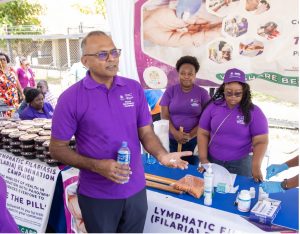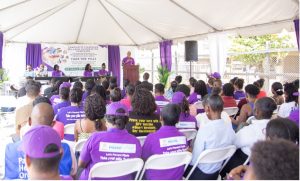The Ministry of Health, in collaboration with the Pan American Health Organization/World Health Organization (PAHO/WHO), today launched the 2025 phase of Guyana’s national campaign to eliminate lymphatic filariasis (filaria), a mosquito-borne disease that has impacted Guyanese communities for more than a century. The official launch was held on the tarmac of the National Cultural Centre in Georgetown, marking a renewed national effort toward achieving a filariasis-free Guyana by 2030.
Minister of Health, the Honourable Dr. Frank Anthony, underscored the importance of this initiative, describing it as a pivotal milestone in Guyana’s pursuit of the World Health Organization’s disease elimination targets.
“This morning, we continue a journey that began many years ago; a journey to rid our nation of a disease that has caused pain, disfigurement, and suffering for generations,” Minister Anthony stated. “We now have the science, the medicines, and the global support to finish this work once and for all.”
Significant progress has already been made, with eight of the country’s ten regions recording infection rates below the one percent elimination threshold established by the WHO. The current campaign will therefore focus on the remaining two regions, Region 3 (Essequibo Islands–West Demerara) and Region 4 (Demerara–Mahaica), to achieve complete national elimination.
Lymphatic filariasis is transmitted through bites from infected mosquitoes, including species of Culex, Anopheles, and Aedes. When mosquitoes bite an infected person, they can ingest microscopic worms (microfilariae), which are then transmitted to others through subsequent bites. These worms inhabit the human lymphatic system and, over time, can cause severe swelling of the limbs and other body parts, leading to conditions such as lymphoedema or elephantiasis, commonly known as “bigfoot” and hydrocele. These conditions can also affect the breasts and genital organs, leading to physical disability, social stigma, and economic hardship.
Through extensive research and successful field interventions, the Ministry has identified mass drug administration (MDA) as the most effective method for breaking the transmission cycle. The MDA strategy involves distributing a combination of three proven medications: Albendazole, Diethylcarbamazine (DEC), and Ivermectin, which together eliminate the worms from the human body. Once treated, individuals no longer serve as reservoirs of infection, effectively stopping further transmission.

The Honourable Dr. Frank Anthony, Minister of Health and resident of Region Four, received his dose of the triple-drug therapy during the official launch of the Lymphatic Filariasis Elimination Campaign today.
More than 639 trained personnel, including pill distributors and supervisors, will conduct house-to-house visits throughout Regions 3 and 4. These teams will ensure that residents receive accurate information about the program and take the prescribed medications. The Ministry of Health, together with PAHO/WHO, will provide ongoing monitoring and verification of the campaign’s progress through daily reporting and field supervision.
“Our success depends not only on science but on people, we must reach every home, talk to every family, and ensure that everyone understands why taking these tablets matters. This is how we protect each other and our nation,” Minister Anthony emphasised.
Guyana’s fight against filaria dates back to the early 1900s, with past interventions including the use of DEC in table salt, yielding partial success. The current triple-drug therapy, known as IDA (Ivermectin, Diethylcarbamazine, and Albendazole), has proven to be far more effective when administered correctly. Minister Anthony reaffirmed the government’s goal of achieving complete elimination of filaria by 2030, highlighting that Guyana is now closer than ever to eradicating the disease.
Beyond lymphatic filariasis, Dr Anthony disclosed that the Ministry of Health is advancing its broader vision to eliminate several other infectious diseases, including Chagas disease, leishmaniasis, leprosy, hepatitis C, and malaria. Recent regional training sessions with PAHO experts have strengthened leprosy elimination strategies, with no new cases reported among children, an encouraging indicator of progress. In the fight against hepatitis C, treatment costs have been reduced from over US$1,500 to under US$100 per patient through PAHO-negotiated access, enabling free treatment across the country. Meanwhile, Guyana’s malaria program is transitioning from control to elimination, with intensified interventions in endemic Regions 1, 7, 8, and 9.

Honourable Dr Frank Anthony, Minister of Health speaking at the launch of the Lymphatic Filariasis campaign
The Health Minister noted that the elimination of these long-standing diseases will free resources to address emerging health threats linked to climate change and global travel.
“As we fight these ancient diseases, we must free up space to deal with new and emerging infections. COVID-19 showed us the importance of preparedness. We must build resilient systems to respond swiftly to whatever comes next,” he said.
The Ministry urges all eligible residents in Regions 3 and 4 to fully support the national filaria elimination campaign. Children under two years of age, pregnant women, and individuals who are severely ill are exempted from taking the medication, but all other eligible persons are encouraged to participate.
“Let’s work hard together over the next few weeks to make this program the most successful in our country’s history,” Minister Anthony concluded.
Meanwhile, Dr Kim Dickson, PAHO/WHO Guyana Country Representative said the current campaign forms part of the PAHO Elimination Initiative, a regional strategy aimed at ending more than 30 communicable diseases and related conditions in the Americas by 2030. This innovative, integrated, and sustainable approach seeks to accelerate progress in improving the quality of life for people and communities across the region.
Speaking at the launch, Dr Dickson reaffirmed the organisation’s unwavering support to the Ministry of Health and the people of Guyana:
“Our goal is simple yet profound, to improve the quality of life for people and communities. And we know that this is possible. The Americas have proven that elimination is achievable when we work together. Today, Guyana stands once again as a trailblazer in public health.”
Guyana has long demonstrated leadership in disease elimination, being among the first countries to adopt the integrated approach targeting seven priority diseases, including lymphatic filariasis, canine rabies, and the prevention of mother-to-child transmission of Human Immunodeficiency Virus (HIV).

